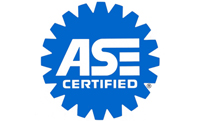How often
should belts and hoses be replaced
Most hose manufacturers recommend replacing hoses every four
years. V-belts should be replaced every three years or
36,000 miles. The incidence of failure rises sharply after
the fourth year of service for hoses and third year for
belts.
The lifespan of a typical serpentine belt is about five
years or 50,000 miles. Serpentine belts are thinner and more
flexible than V-belts. They run cooler and last longer, but
cost about twice as much to replace.
The hard part is convincing customers to change belts and
hoses as preventative maintenance BEFORE they fail. Few
people do, yet they could save themselves a lot of
unnecessary grief and expense if they would.
Rubber hoses deteriorate with age. Tiny cracks develop in
the rubber which eventually cause hoses to split, blister or
leak. Oil contamination and atmospheric ozone can accelerate
the process.
Engine vibration and motion can cause hoses to wear if they
are too short or rub against other parts. This applies to
fuel, vacuum and emission hoses as well as coolant hoses.
A visual inspection will often uncover bad hoses. Pinching
hoses to check for age cracks, brittleness or mushiness can
also help locate hoses that need to be changed.
However, neither technique will reveal all the hoses that
might need replacing because hoses wear as much from the
inside out as they do from the outside in. A hose that
appears okay on the outside may actually be on the verge of
failure because of internal deterioration.
According to research done by one hose manufacturer,
internal corrosion caused by electrochemical degradation is
the primary cause of cooling system hose failure.
The coolant acts like an electrolyte and allows a current to
flow between engine and radiator. This causes micro-cracks
to form inside the hose which eventually leads to pinhole
leaks and weakening of hose fibers.
With belts, heat and mileage are the main causes of wear.
Every time a belt passes around a pulley, it bends and
flexes. This produces heat which hardens the rubber over
time. The wear process is greatly accelerated if the belt is
loose and slips.
The additional friction between belt and pulley will make a
belt run hotter. After millions of journeys around the
pulleys, even the best drive belt begins to suffer the
effects of age. Rubber begins to crack and fray and the
internal cords become weak and brittle.
You cannot always determine a belt's true condition by
appearances alone. Any belt obviously cracked and frayed
should be replaced. With many of today's bandless belts,
there is no outside cover to peel loose and betray the
belt's deteriorated condition.
A belt may appear to be like new on the outside, yet be on
the verge of failure because of weakened separated cords
inside.
When a belt is replaced, it is important that the belt be
properly tensioned. If too loose, it will slip and wear
quickly. If too tight, it may damage internal cords as well
as overload shaft bearings on accessories it drives.
The rule of thumb about tightening a belt until there is
about half an inch of give between the two furthest pulleys
is not always accurate. A belt gauge" that measures actual
tension is the only sure way to know if a belt is tensioned
properly.
Because a V-belt normally takes a set after a few minutes of
running, one set of tension specs may be provided for new
belts and another for used belts. Any V-belt that has been
run for more than 15 minutes should be considered a used
belt.
OneStop Auto Shop
Call Today for
all of your Auto Repairs
and Maintenance
in Hollywood, Ca.!
(323) 227-9999
|






















